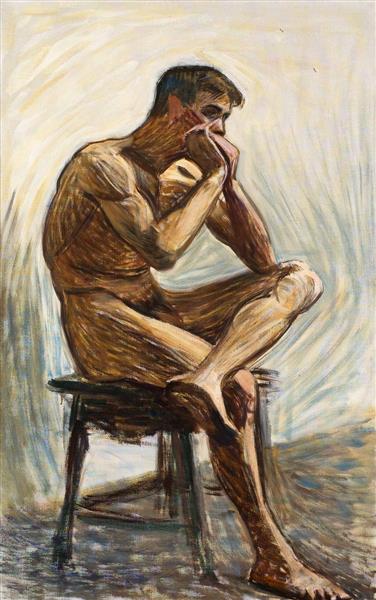Description
In the work "Nu Assis" of 1907, Eugène Jansson shows his mastery in the representation of the female nude, a recurring theme in the history of art that allows the artist to explore forms, textures and emotions in a deeply intimate way. The painting reveals an acute knowledge of human anatomy and a technical ability that challenges the viewer to reflect on the beauty of the body in its purest form. Jansson, a prominent representative of the symbolism and the Scandinavian movement of the late nineteenth and early twentieth centuries, becomes in this work a vibrant energy that resonates beyond simple contours, awakening both visual and emotional sensations.
He painting It focuses on a female figure that occupies almost all available space. His posture, with slightly flexed legs and the torso turned, suggests an introspective and serene presence. The body's shape is idealized, but there is also a noticeable attention to naturalism, something characteristic of Jansson's technique. The woman's skin is represented with soft color gradations that evoke softness and warmth, contrasting with the darkest background, which not only highlights the figure, but also creates a surround and almost dreamlike environment. This chromatic contrast, where terracotta and beige tones predominate on a deep blue background, reinforces visual drama and leads the observer to a reflection on the light, the shadow and the dimension of space.
The chromatic choice is not accidental; Jansson uses a palette that evokes a tension between the earthly and the spiritual. Through these colors, the artist seems to ask about the relationship between the human figure and its surroundings, suggesting a connection that crosses the physical and points towards an ideal of beauty that places the viewer in a state of contemplation. The resulting atmosphere is both serenity and force, letting the figure not only be present, but also dialogue with the surrounding space.
Although in "nu assis" there is no obvious narrative context, the figure becomes a symbol of the search for female identity at the beginning of the 20th century, a period in which discussions on the role of women in society began To collect impulse. The work can be interpreted as a claim of female freedom, a celebration of the body as an autonomous entity that inhabits a world that often, the kontrol. This social aspect of the work can enrich the viewer's experience, creating a bridge between aesthetics and critical reflection on the role of women in society.
Throughout his career, Jansson developed a series of works that, like this, challenge the artistic conventions of his time. His nudes evoke a subtle mysticism, inspired by symbolism, which manifests itself in the way in which bodies seem immersed in their own worlds, instead of being mere objective representations. The exploration of the human figure in "Nu Assis" reflects the influence of its Scandinavian cultural environment and its connection with emerging modernism, where individuality and personal expression began to prevail over traditional forms of representation.
In conclusion, "Nu Assis" by Eugène Jansson is not only a painting Nude, but an invitation to explore the relationship between body and space, between the individual and society. Through his technique and his palette, Jansson manages to capture an essence that transcends the visual, transforming the work into a milestone of the painting of the early twentieth century. With each contemplation, the viewer is imbued in a dialogue that covers the aesthetic and the philosophical, which makes this work not only an object of artistic admiration, but also a vehicle for deep reflection on the human condition.
KUADROS ©, a famous paint on your wall.
Hand-made oil painting reproductions, with the quality of professional artists and the distinctive seal of KUADROS ©.
Art reproduction service with satisfaction guarantee. If you are not completely satisfied with the replica of your painting, we refund your money 100%.

